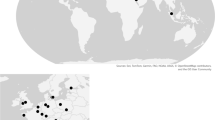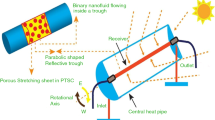Abstract
Triple point data are important in the refrigerating industry, defining the lowest temperature limit at which a refrigerant may circulate in a fluid state. For several refrigerants, triple point data present in the literature are extremely scarce or inaccurate. A recently developed Solid–Liquid Equilibria (SLE) apparatus was used to measure the triple point temperature of 16 of the most widely applied alternative refrigerants, namely three methane derivatives (fluoromethane, R41; difluoromethane, R32; trifluoromethane, R23), four ethane derivatives (pentafluoroethane, R125; 1,1,1,2-tetrafluoroethane, R134a; 1,1,1-trifluoroethane, R143a; 1,1-difluoroethane, R152a), five propane derivatives [1,1,1,2,3,3,3-heptafluoropropane, R227ea; 1,1,2,3,3,3-hexafluoropropane, R236ea; 1,1,1,3,3-Pentafluoropropane, R245fa; 1,1,2,2,3-pentafluoropropane, R245ca; 1,1,1,3,3,3-hexafluoropropane, R236fa), and four hydrofluoro-olefines (2,3,3,3-tetrafluoroprop-1-ene, R1234yf; trans-1,3,3,3 tetrafluoropropene, R1234ze(E); 3,3,3-trifluoropropene, R1243zf; 1,2,3,3,3-pentafluoropropene, 1225ye(Z)]. The experimental setup, that was recently adopted for the SLE estimation of binary systems containing carbon dioxide (J Therm Anal Calorim 105:489–493, 2011), comprises a measuring cell and a system for drawing the liquid nitrogen directly from its insulated tank with the aid of compressed air: the carrier fluid circulating in the circuit is thus the refrigerant itself. The measurements were performed both in the heating and in the cooling mode. In order to confirm the functional efficiency and fine adjustment of the apparatus, the already available triple point literature data for carbon dioxide, dimethyl ether, and nitrous oxide were also compared with the ones measured by the present setup, confirming the validity of the setup. The measured triple point data for the refrigerants revealed generally good agreement with the literature, excepting a few fluids that revealed some discrepancies.



Similar content being viewed by others
References
Arteconi A, Di Nicola G, Moglie M, Santori G, Stryjek R. Alternative biofuels: PVTx measurements for DME + propane. J Therm Anal Calorim. 2010;99:899–903.
Di Nicola G, Giuliani G, Polonara F, Stryjek R. Solid-liquid equilibria for the CO2 + R125, and N2O + R125 systems: a new apparatus. J Chem Eng Data. 2006;51:2209–14.
Beyerlein AL, DesMarteau DD, Hwang SH, Smith ND, Joyner PA. Physical properties of fluorinated propane and butane derivatives as alternative refrigerants. ASHRAE Trans. 1993;99:368–79.
Mair BJ, Glasgow JAR, Rossini FD. Determination of the freezing points and amounts of impurity in hydrocarbons from freezing and melting curves. J Res Nat Bur Standards. 1941;26:591–620.
Angus S, Armstrong B, de Reuck KM. International thermodynamic tables of the fluid state—3 carbon dioxide. New York: Pergamon; 1976.
Calado JCG, Rebelo LPN, Streett WB, Zollweg JA. Thermodynamics of liquid (dimethylether + xenon). J Chem Thermodyn. 1986;18:931–8.
Fonseca IMA, Lobo LQ. Thermodynamics of liquid mixtures of xenon and methyl fluoride. Fluid Phase Equilib. 1989;47:249–63.
Ihmels EC, Lemmon EW. Experimental densities, vapor pressures, and critical point, and a fundamental equation of state for dimethyl ether. Fluid Phase Equilib. 2007;260:36–48.
Stull DR, EF Westrum Jr, Sinke GC. The chemical thermodynamics of organic compounds. New York: John Wiley and Sons; 1969.
Magee JW, Duarte-Garza HA. Molar heat capacity at constant volume of trifluoromethane (R23) from the triple-point temperature to 342 K at pressures to 33 MPa. Int J Thermophys. 2000;21:1351–72.
Lüddecke TO, Magee JW. Molar heat capacity at constant volume of difluoromethane (R32) and pentafluoroethane (R125) from the triple-point temperature to 345 K at pressures to 35 MPa. Int J Thermophys. 1996;17:823–49.
Magee JW. In: Holcomb CD, Magee JW, Scott JL, Outcalt SL, Haynes WM, editors. NIST technical note 1397; 1997. p. 14.
Tillner-Roth R, Baehr HD. An international standard formulation of the thermodynamic properties of 1, 1, 1, 2-tetrafluoroethane (HFC-134a) for temperatures from 170 K to 455 K at pressures up to 70 MPa. J Phys Chem Ref Data. 1994;23:657–729.
Magee JW. Molar heat capacity at constant volume of 1,1-difluoroethane (R152a) and 1,1,1-trifluoroethane (R143a) from the triple-point temperature to 345 K at pressures to 35 MPa. Int J Thermophys. 1998;19:1397–420.
Blanke W, Weiss R. Isochoric (p, v, T) measurements on C2H4F2 (R152a) in the liquid state from the triple point to 450 K and at pressures up to 30 MPa. Fluid Phase Equilib. 1992;80:179–90.
Minor B, Spatz M. HFO-1234yf low GWP refrigerant update. International refrigeration and air conditioning conference at Purdue, paper 2349, 14–17 July 2008, pp. 1–8.
Lemmon EW, Huber ML, McLinden MO. NIST standard reference database 23: reference fluid thermodynamic and transport properties-REFPROP, Version 9.0, National Institute of Standards and Technology, Standard Reference Data Program, Gaithersburg; 2010.
Di Nicola G, Moglie M, Stryjek R, Santori G. Solid–liquid equilibria for the dimethyl ether + carbon dioxide binary system. J Therm Anal Calorim. 2011;105:489–93.
Author information
Authors and Affiliations
Corresponding author
Rights and permissions
About this article
Cite this article
Di Nicola, G., Brandoni, C., Di Nicola, C. et al. Triple point measurements for alternative refrigerants. J Therm Anal Calorim 108, 627–631 (2012). https://doi.org/10.1007/s10973-011-1944-4
Published:
Issue Date:
DOI: https://doi.org/10.1007/s10973-011-1944-4




